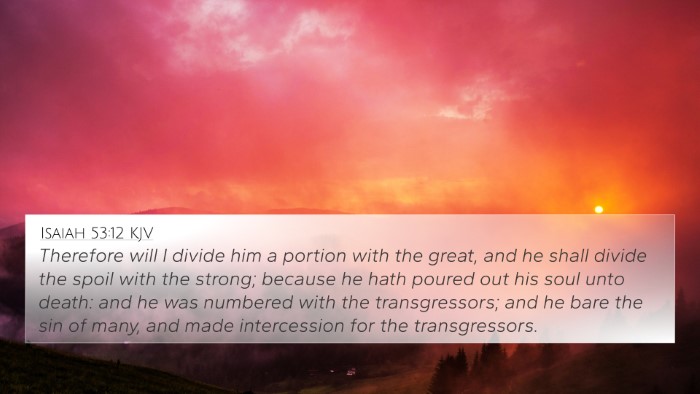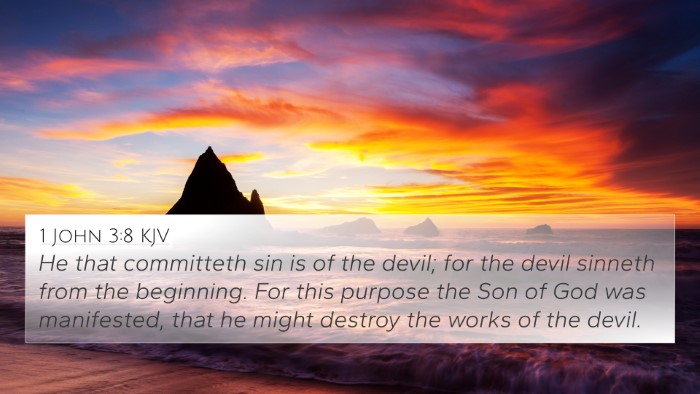Understanding Matthew 12:29
Verse: "Or else how can one enter into a strong man's house, and spoil his goods, except he first bind the strong man? and then he will spoil his house." - Matthew 12:29 (KJV)
Summary of Biblical Meaning
This verse speaks of the necessity of overcoming the strong man—representative of Satan or demonic powers—before one can achieve victory over his domain, namely, the lives of those whom he oppresses. In the broader context, this verse emphasizes Jesus' authority and power over evil spirits and sin, describing the nature of spiritual warfare.
Commentary Insights
Insights from public domain commentaries shed light on the implications and meanings of this verse:
-
Matthew Henry:
Henry emphasizes the necessity of spiritual preparation. The "strong man" represents Satan whose house is the dominion of sin. To rescue souls from Satan, one must first neutralize his power, which is accomplished through the authority of Christ.
-
Albert Barnes:
Barnes points out that binding the strong man implies the defeat of evil before the ministry of Christ can effectively liberate those under oppression. This reflects the strategic nature of Jesus’ mission on earth and asserts that spiritual conflict requires divine authority.
-
Adam Clarke:
Clarke elaborates on the metaphor of the strong man and his house, suggesting that true victory in spiritual battles requires confrontation and power over that which keeps individuals in bondage. Clarke's insight suggests that Jesus' exorcism and healings illustrate his binding of the strong man, leading to spiritual liberation.
Cross References
- Luke 11:21-22: This passage parallels Matthew 12:29 by emphasizing the need to bind the strong man before plundering his house, reinforcing the theme of Jesus' authority over demons.
- Mark 3:27: Similar to Matthew 12:29, Mark underscores the same concept of binding the strong man as a prerequisite for spoiling his goods.
- Romans 16:20: This verse reassures that the God of peace will soon crush Satan under the feet of believers, illustrating the ultimate victory over the strong man.
- 1 John 3:8: This verse states that Jesus appeared to destroy the works of the devil, which ties directly into the idea of binding the strong man.
- Colossians 1:13: Here, Paul discusses being delivered from the domain of darkness, connecting with the ideas present in Matthew 12:29 about spiritual liberation.
- John 10:10: Jesus describes Himself as the good shepherd who came to give life abundantly, framing spiritual warfare as a means of giving life against the backdrop of the enemy's destruction.
- Ephesians 6:12: Paul speaks of wrestling not against flesh and blood but against principalities and powers, reinforcing the need for divine strength in spiritual battles.
Thematic Connections
This verse connects to broader themes within the Bible, such as:
- Spiritual Warfare: Identifying the need for believers to engage in spiritual battles against evil forces.
- The Authority of Christ: Highlighting the power of Jesus over demonic entities, emphasizing His divine authority.
- Redemption and Deliverance: Showing that life in Christ leads to freedom from sin and captivity.
Conclusion
In examining Matthew 12:29 through the lens of various commentaries, it becomes clear that the verse serves as a profound insight into the nature of Christ's mission against evil. By binding the strong man, Jesus signifies the authority needed to liberate those who are spiritually oppressed. For those searching for related Bible verses or studying cross-references, the above insights provide valuable connections that enhance understanding of spiritual themes throughout Scripture.
Further Study
To gain deeper insights into the connections between various Bible verses, consider using tools for Bible cross-referencing, such as a Bible concordance or cross-reference guide. Engaging in cross-referencing Bible study methods can reveal intricate links between the Old and New Testament, shedding light on themes related to Matthew 12:29.











